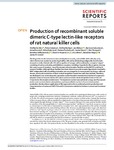Production of recombinant soluble dimeric C-type lectin-like receptors of rat natural killer cells
Vaněk, Ondřej
Celadova, Petra
Skořepa, Ondřej
Bláha, Jan
Kalousková, Barbora
Dvorská, Anna
Poláchová, Edita
Kavan, Daniel
Pompach, Petr
Hofbauerová, Kateřina
Kopecký Jr., Vladimír
Mesci, Aruz
Voigt, Sebastian
Carlyle, James R.
Working at the border between innate and adaptive immunity, natural killer (NK) cells play a key role in the immune system by protecting healthy cells and by eliminating malignantly transformed, stressed or virally infected cells. NK cell recognition of a target cell is mediated by a receptor “zipper” consisting of various activating and inhibitory receptors, including C-type lectin-like receptors. Among this major group of receptors, two of the largest rodent receptor families are the NKR-P1 and the Clr receptor families. Although these families have been shown to encode receptor-ligand pairs involved in MHC-independent self-nonself discrimination and are a target for immune evasion by tumour cells and viruses, structural mechanisms of their mutual recognition remain less well characterized. Therefore, we developed a non-viral eukaryotic expression system based on transient transfection of suspension-adapted human embryonic kidney 293 cells to produce soluble native disulphide dimers of NK cell C-type lectin-like receptor ectodomains. The expression system was optimized using green fluorescent protein and secreted alkaline phosphatase, easily quantifiable markers of recombinant protein production. We describe an application of this approach to the recombinant protein production and characterization of native rat NKR-P1B and Clr-11 proteins suitable for further structural and functional studies.
Files in this item

